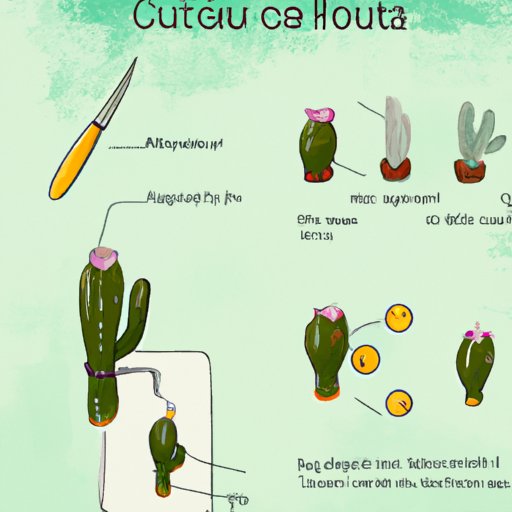
Introduction
Drawing cacti can be a bit daunting for some artists. Their unique shapes and spines can make them seem difficult to capture on paper. But fear not, as this guide is designed to make the process easier and more enjoyable. In this article, we’ll explore the step-by-step process of drawing a cactus, the materials needed, tips for getting proportions and details right, and much more.
A Step-by-Step Guide to Drawing a Cactus
Before we begin, let’s gather the materials needed for drawing a cactus. You’ll need a pencil, eraser, drawing paper, and a ruler (optional).
Now, let’s start our step-by-step process with the basic shape of the cactus. Start by drawing a rounded oval or oblong shape for the body. Then, draw a few lines extending from the top of the oval to create the arms of the cactus. Don’t worry about making them perfectly straight, as natural cacti are often slightly crooked or curved.
Next, add detail to the cactus by drawing its spines. Use short, sharp lines extending from the arms and body of the cactus to represent the spines. Vary the length and thickness of the spines to create interest and realism.
Once you have the basic shape and spines of the cactus drawn, it’s time to add some color and shading. Choose your preferred medium (such as colored pencils or markers) and add color to the body and arms of the cactus. Make sure to blend the colors together smoothly for a realistic look.
Finally, add shading to the cactus to create depth. Shade in areas where shadows would naturally form, such as the spaces under the arms and around the spines. This will add dimension to the drawing and make it more lifelike.
Remember, don’t be too hard on yourself if your first attempt isn’t perfect. Drawing is all about practice and experimentation, so keep on trying until you’re happy with the result.
Understanding the Anatomy of a Cactus
One of the keys to drawing a cactus successfully is understanding its anatomy. Different cactus species have unique shapes and features, so it’s important to study them before drawing.
Start by researching different cacti species and their features. Look at photos or illustrations of the plants and take note of their various shapes, spines, and colors. This will help you create a more accurate and realistic drawing.
Next, study the anatomy of a cactus. Cacti have a few key features, including their ribbed bodies, spines, and areolas (the small bumps on the cactus where the spines grow from). Understanding the placement and shape of these features will make your drawing more accurate.
Using Different Materials to Draw Cacti
Experimenting with different drawing materials can be a fun way to create unique effects in your cactus drawings. Try using colored pencils, markers, watercolors, or even pastels to add texture and depth to your illustrations.
For example, colored pencils are great for layering and blending colors. This can create a smooth, realistic look for your cactus drawings. On the other hand, markers are perfect for creating bold lines and vibrant colors. Consider using different materials for different parts of your drawing to create interesting contrast and variety.
Drawing Cacti in Different Settings
Cacti are often associated with desert landscapes, but they can also be part of indoor plant collections. Experiment with drawing cacti in different settings to create different moods and styles.
For example, drawing a cactus in a desert landscape with a bright blue sky and hot sun can create a warm and inviting feeling. On the other hand, drawing a cactus as part of an indoor plant collection with soft lighting can create a cozy and inviting atmosphere.
Tips for Adding Depth and Texture to Cactus Drawings
Adding depth and texture to your cactus drawings can make them more interesting and realistic. Try using shading techniques like crosshatching or stippling to create shadows and variation in the texture.
For example, using crosshatching (drawing small, intersecting lines) to shade the body of the cactus can create realistic depth and texture. Stippling (drawing small dots) can also be used to create texture in the spines and areolas of the cactus.
Drawing Cute and Cartoonish Cacti
If you’re looking for a playful and whimsical approach to drawing cacti, try creating cute and cartoonish illustrations. One way to simplify the cactus shape is to make it more rounded and less spiky. Add an adorable face or other fun details to create a unique character.
Consider using bright colors and bold lines to give your cartoonish cacti more personality. Don’t be afraid to play around with different styles and techniques to create something truly one-of-a-kind.
Conclusion
Drawing cacti is not as difficult as it may initially seem. With a little knowledge of cactus anatomy, some basic drawing techniques, and a bit of creativity, anyone can create a stunning cactus illustration. Remember to experiment with different materials and styles, and don’t be afraid to make mistakes. Keep practicing, and soon you’ll be a cactus-drawing pro.
Remember, the most important thing when it comes to drawing is having fun. Enjoy the process of creating something new and unique.




